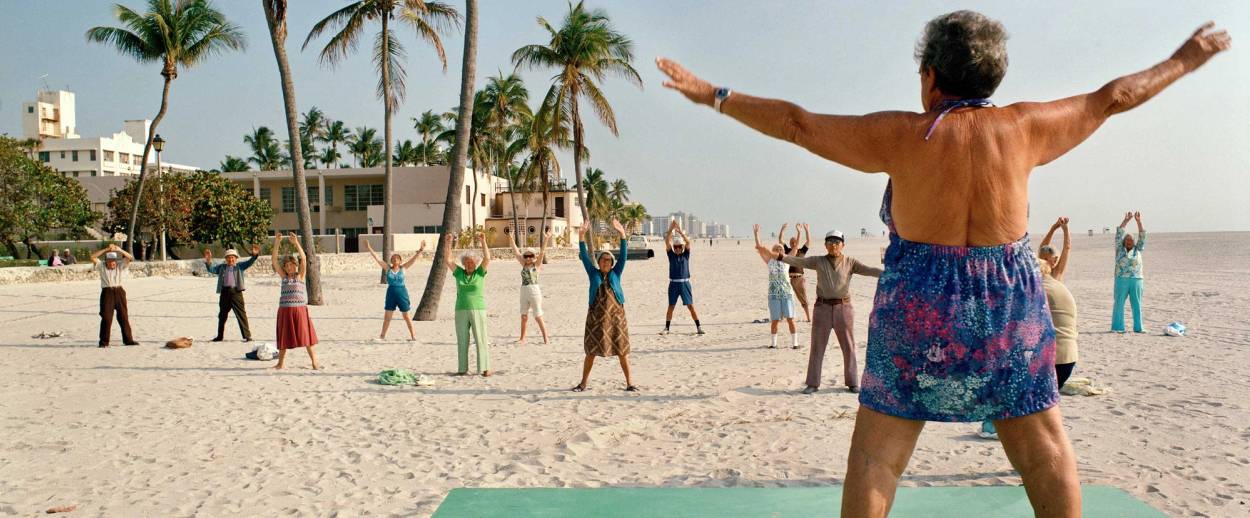Going South for the Winter
How Florida became home to Jewish snowbirds




Snowbird: noun
1) Dark-eyed Junco, a member of the sparrow family whose sudden appearance at feeding stations heralds the coming of winter
2) Migrant workers of the 1920s who, together with the unemployed, went south in search of jobs
3) Uncle Bob and Aunt Lil, Uncle Norman and Aunt Sonny
Once the days grow shorter and chillier, thousands of American Jews like my aunts and uncles temporarily pull up stakes and head south for a couple of months. Some lit out for Charleston or Hilton Head, South Carolina. Others make a beeline for Delray Beach or Boca Raton, Florida, where, living either in a high-rise condo or in a gated community with a fanciful name, they enjoy the good life: long walks on the beach (or at the mall); eating early and frequently; a round of golf or a quick dip in the pool; and the occasional visit from the grandchildren.
As much a collective phenomenon as a seasonal one, the migration of large segments of the population from one region of the country to another has become a defining feature of modern life, especially among America’s Jews. It just might be one of the few things they have in common. Think of it this way: Surely it’s not for nothing that references to condos and golf and 5 p.m. dinners are thick on the ground in various and sundry episodes of Seinfeld. They are there because they’re funny and they’re funny because they hit close to home.
Less familiar by far are the origins of snowbirding, or what sociologists like to call “retirement migration.” Affluence, the portability of Social Security checks, and heightened “quality of life” expectations, let alone a longer lifespan, had much to do with rendering it feasible for so many. Technology was another key factor. Were it not for air-conditioning to keep the humidity at bay, DDT to keep the mosquitos at arm’s length, and bulldozers to eliminate the swampy mangroves, Greater Miami would have remained a “mudhole” rather than a mecca. Meanwhile, increasing talk in postwar America about the therapeutic value of warm weather—it was believed to replace a “waspish temper” with “mental tranquility”—furthered the region’s appeal, as did the growing affordability of air travel.
American Jews were quick to take note. In some instances, clever promotional gambits brought the Sunshine State to their attention. As early as 1950, Eastern Airlines placed a boldly scaled neon sign on the New Jersey side of the Hudson River that kept weather-weary locals, encumbered by hats, gloves, and heavy winter coasts, abreast of balmy Florida temperatures. Talk about messaging!
In other instances, American Jews drew on memories of having been stationed in Miami Beach during WWII. As historian Deborah Dash Moore explains in her definitive account, To the Golden Cities: Pursuing the American Jewish Dream in Miami and L.A., the “Army introduced Jews … to the American South,” where the “promise of life on the Beach captivated many soldiers who vowed to return.”
Whatever their motivations, urban American Jews flocked to Miami Beach like “homing pigeons,” accounting by the late 1960s for an estimated 80 percent of its population and generating all manner of commentary, some of it rather disturbing by today’s cultural standards. Consider, for example, an article about winter vacations that ran in The New York Times in 1950 in which the ways of sun-worshippers were pitted against those who preferred the snow. “One of the most passionate North-South controversies since the Second Battle of Bull Run is the seasonal dispute between winter vacationists,” it quipped, before offering up quasi-ethnographic characterizations of those who fell within each camp.
“The patron of the palms,” the paper of record observed, “is, more often than not, a man of ample means and a hysterical sport shirt. … For the most part, he purchases his pleasure rather than make it himself. He is the spectator rather than the participant.” Sound familiar? If not, the Times account left little doubt in the minds of its readers as to the Jewish identity of its subject by expounding at some length on the respective culinary preferences of the sun-worshipper and the skier. When it came to chowing down, those who vacationed in Miami Beach, we are told, had their pick of “flashy, upholstered all night delicatessens that carry a full line of temptations from garlic pickles to ice cream.” In contrast, the food consumed on the ski trail—flapjacks and Idaho backed potatoes—was associated with restraint and wholesomeness.
Increasingly mindful of public characterizations like this one, and concerned lest they give way to even more anti-Semitism than was already in place (back in the day, many areas in Florida, including Delray Beach and Fort Lauderdale, were restricted, off limits to Jews), the ADL cautioned its coreligionists to mind their manners, to practice politesse and discretion, when on vacation.
Were the organization’s warnings heeded? It’s hard to say. But, clearly, they did little to act as a deterrent. America’s Jews kept coming—and for longer stretches of time: first, as tourists, then as snowbirds and, most recently, according to the latest demographic surveys, as permanent residents. “Palm Beach County: More Jewish than New York,” a local newspaper declared in 2005, trotting out statistics—this many synagogues (50) and that many kosher eateries (12-plus) —to make the point that Jewish life was a going concern all year long.
No longer do you have to wait an entire lifetime before entering paradise. The “Eden of the South” is just hours and an airline ticket away.
Jenna Weissman Joselit, the Charles E. Smith Professor of Judaic Studies & Professor of History at the George Washington University, is currently at work on a biography of Mordecai M. Kaplan.